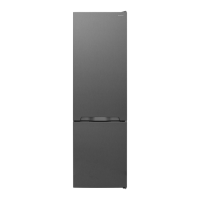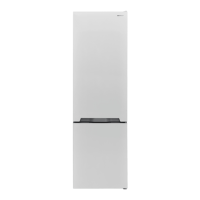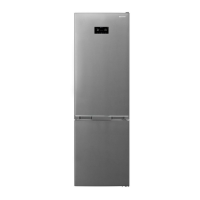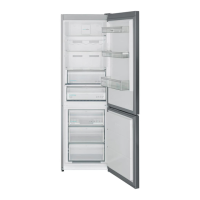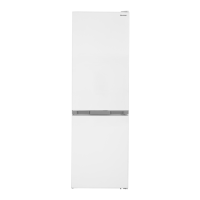EN - 9
2 DESCRIPTION OF THE
APPLIANCE
This appliance is not intended to be used
as a built-in appliance.
Thermostat knob
Lamp cover
1
2
5
6
7
8
9
4
B
11
12
A
13 14
3
10
This presentation is only for
information about the parts of the
appliance. Parts may vary according to the
appliance model.
A) Refrigerator compartment
B) Freezer compartment
1) Wine rack *
2) Refrigerator shelves
3) Crisper cover
4) Crisper
5) Freezer upper basket
6) Freezer middle basket
7) Freezer bottom basket
8) Levelling feet
9) Freezer glass shelves *
10) Bottle shelf
11) Adjustable door shelf * / door shelf
12) Door shelf
13) Egg holder
14) Ice box tray
* In some models
General notes:
Fresh Food Compartment (Fridge): Most
ecient use of energy is ensured in the
conguration with the drawers in the bottom
part of the appliance, and shelves evenly
distributed, position of door bins does not
aect energy consumption.
Freezer Compartment (Freezer): Most
Ecient use of energy is ensured in the
conguration with the drawers and bins are
on stock position.
3 USING THE APPLIANCE
3.1 Information about New Generation
Cooling Technology
Fridges with new-generation cooling
technology have a dierent operating
system to static fridges. Other (static)
fridges may experience a build up of ice
in the freezer compartment due to door
openings and humidity in the food. In such
fridges, regular defrosting is required; the
fridge must be switched o, the frozen
food moved to a suitable container and
the ice which has formed in the freezer
compartment removed.
In fridges with new-generation cooling
technology, a fan blows dry cold air
evenly throughout the fridge and freezer
compartments. The cold air cools your food
evenly and uniformly, preventing humidity
and ice build-up.
In the refrigerator compartment, air
blown by the fan, located at the top of
the refrigerator compartment, is cooled
while passing through the gap behind
the air duct. At the same time, the air is

